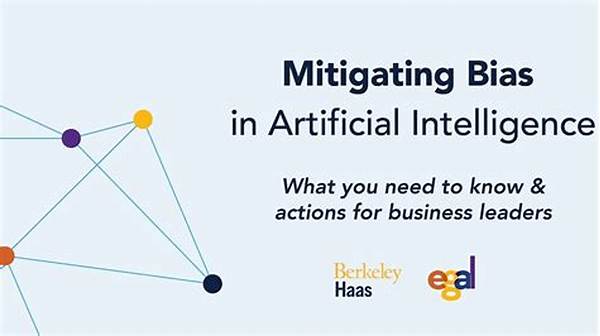Mitigating Algorithmic Bias in Datasets
The Beginning of a Crucial Conversation
In the modern world, where data not only informs decisions but actively drives policy, development, and personal experiences, the concept of “algorithmic bias” takes center stage like a blockbuster movie capturing the hearts and minds of the audience. These biases in algorithms are often not apparent at first glance, but upon deeper examination, can affect both individuals and groups in ways that are subtle yet significant. Welcome to the intricate world of algorithmic decisions! Understanding and mitigating algorithmic bias in datasets is not just an academic challenge but an ethical necessity that demands urgent action for a fairer future.
Imagine algorithms as chefs concocting a stew—a delightful blend of data spices and contextual herbs. But what happens if the ingredients are skewed, the recipe biased? The result is a dish that might delight some while leaving a bitter aftertaste for others. By the time this realization hits, some might argue it’s already too late. That’s why this conversation on mitigating algorithmic bias becomes not just significant but a moral obligation for developers, data scientists, and businesses at large. Just as you wouldn’t skimp on quality control in a factory producing life-saving medical devices, ensuring fairness and impartiality in data-driven decisions is pivotal.
Unpacking the Layers of Bias
While you may be entertained by the narrative, it’s vital to dig deeper into why mitigating algorithmic bias in datasets matters. At its core, bias can creep in through various avenues—be it historical discrimination encoded in data or skewed sample representation. The irony? At times, the bias is an unintentional artifact—a ghost in the machine, unnoticed until it’s too late. Yet, the ramifications are very real, impacting things like employment decisions, judicial judgments, and financial opportunities.
Why Do We Need a Comprehensive Approach?
With stakes so high, the urgency to address this issue cannot be overstated. The rise of AI and machine learning means that these systems are feeding into larger societal mechanisms. A biased decision in a seemingly trivial context can unravel into larger, systemic issues. Experts argue that the more integrated an algorithm becomes in social frameworks, the more susceptible it becomes to amplifying existing biases. Thus, designers, testers, and users alike shoulder a collective responsibility to ensure ethical standards are not just met but continuously upheld.
The Ethical Imperative
Humans have an inherent tendency to default to the path of least resistance, often choosing convenience over contemplation. But when it comes to the implications of AI and machine learning, shrugging off responsibility is no longer an option. The ethical compass must dictate the need for mitigating algorithmic bias in datasets, making conscious efforts to assess, correct, and guard against partialities an intrinsic part of the process.
A Call to Collaborate
In this compelling narrative, the spotlight shines on collaboration. As more stakeholders recognize the magnitude of the task, pooling together resources, expertise, and perspectives form an impregnable front against bias. Whether you’re a tech enthusiast, an activist, a corporate leader, or a curious observer, this is your stage. The call to action is clear: join the conversation, champion fairness, and take proactive steps in mitigating algorithmic bias in datasets. Not just because it’s the right thing to do, but because the future depends on it.
Understanding Bias in Datasets
The Hidden Monsters in Data
Peering into the machinery of data-driven decision-making, we find lurking shadows—algorithmic biases deeply embedded within datasets. Acknowledging their presence is the first crucial step towards eliminating these hidden monsters. To visualize this, imagine exploring a maze where every twist and turn is affected by invisible forces, subtly steering the path and influencing the outcome. Such is the subtle yet pervasive nature of biases within datasets, absorbed seamlessly until they manifest glaringly in significant, real-world decisions.
Scrutinizing the Origins
Delving deeper, we discover that these biases typically originate from historical prejudices, cultural imbalances, and data collection methodologies skewed by omission or overrepresentation. Studies suggest that failure to recognize and address these ingrained biases exacerbates societal disparities, reinforcing privilege while marginalizing vulnerable communities. Researchers continue to uncover how bias manifests across sectors, from law enforcement to healthcare, prompting urgent calls for reform in how data is gathered and utilized.
What Are the Solutions?
The good news is that solutions exist and are being refined. Transparency in algorithm design, diversity in data representation, and continuous auditing are foundational steps in mitigating algorithmic bias in datasets. Whether by deploying automated tools or manual reviews, these efforts aim to dismantle the infrastructure of bias, replacing it with equitable, fair decision-making processes. Regulation plays a supportive role, ensuring the adherence to ethical standards and accountability.
Stories of Change
Encouraging stories emerge from sectors embracing reform. Organizations taking active steps in reducing disparities through conscious data practices add a hopeful dimension to this pressing issue. Be it through engaging with diverse communities or revising algorithms with ethical lenses, examples of perseverance demonstrate what’s possible when commitment meets innovation.
Joining Forces for Greater Impact
Building a community dedicated to mitigating algorithmic bias hinges on shared understanding and proactive participation. It’s a call for collective awakening to peer beyond surface-level solutions, engaging in meaningful dialogue, informed decision-making, and concerted action. As this narrative draws more into its fold, it stands as a testament to what can be accomplished when the stakes are shared, and the resolve is unwavering.

